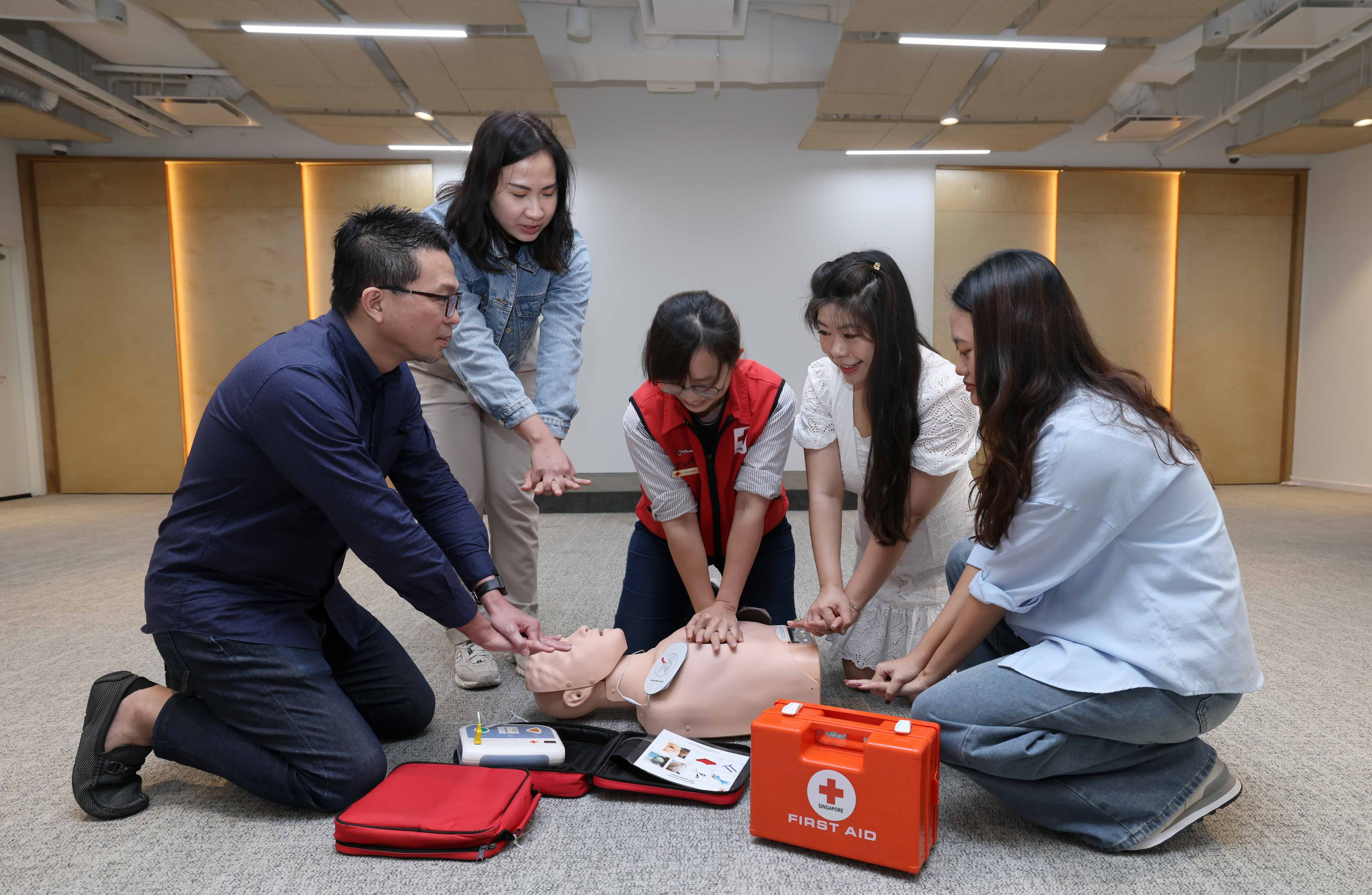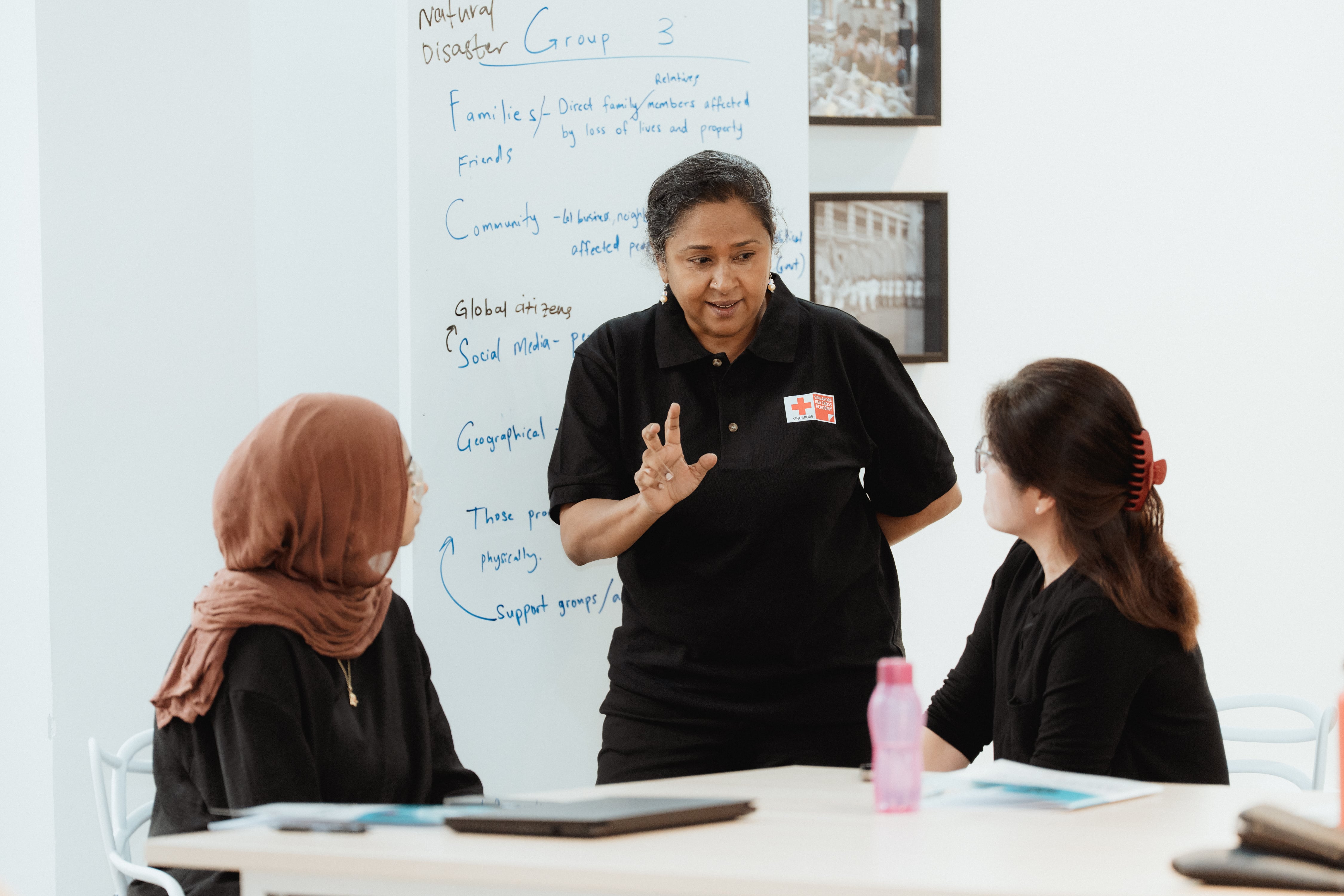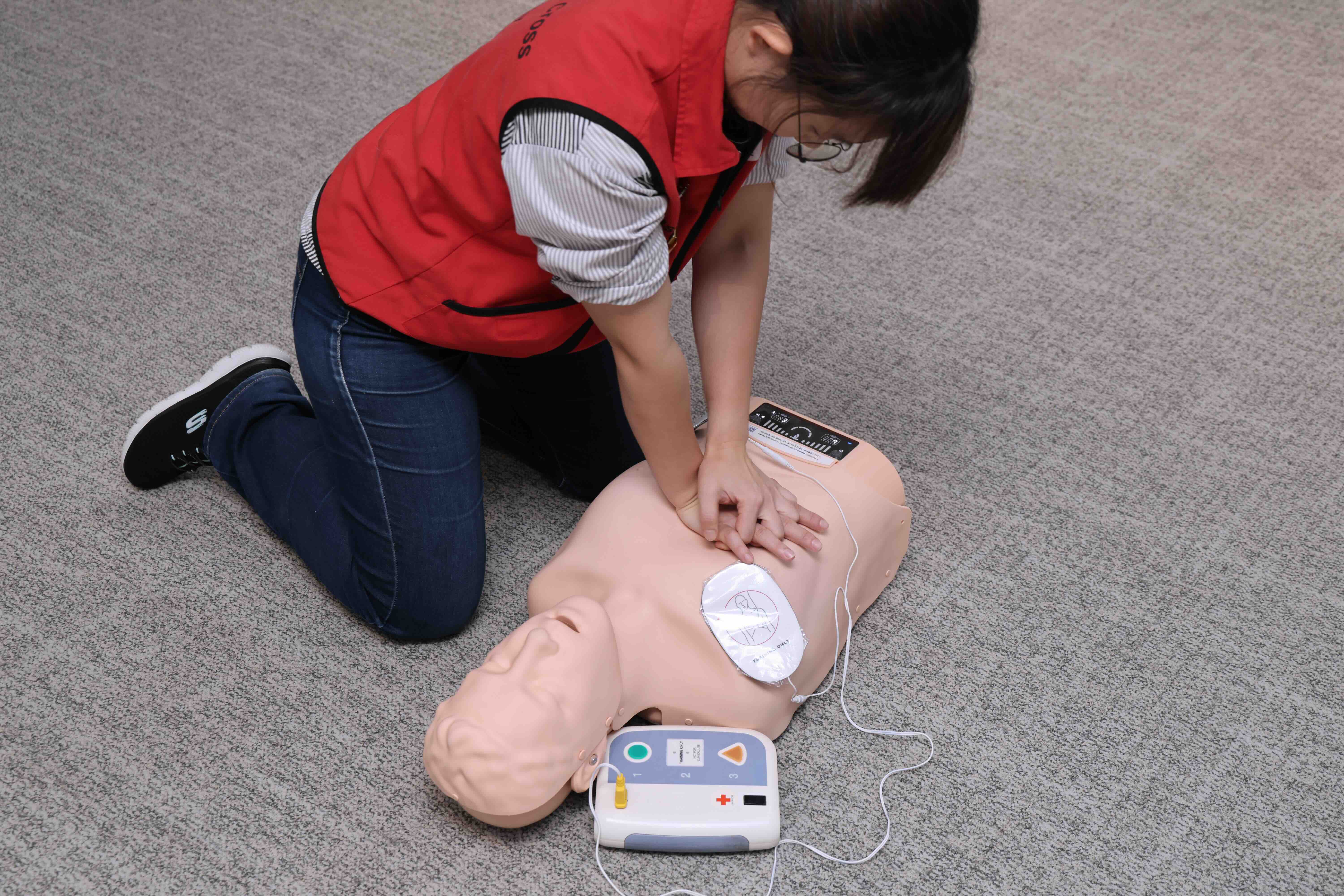
Regular first aid training can transform the panic of facing an emergency into calm, clear, and orderly action. (Photo by Liang Qilin)
|
13 September marks World First Aid Day. Experts explain how first aid and psychological first aid complement each other, share on-site assessment steps, and provide life-saving tips. Volunteer first aid workers share their personal experiences, demonstrating that mastering essential first aid skills can save lives in critical situations. |
From classroom scenario drills to on-site rescue in parks, subways, or shopping malls, mastering first aid and Psychological First Aid (PFA) is not something that only a few people can do. Every member of society can lend a helping hand at critical moments.
A few months ago, 13-year-old Elina Chua, a female student at Cedar Girls’ Secondary School, was studying in her dormitory when she received a sudden cardiac arrest alert from the myResponder app. She immediately contacted her 16-year-old schoolmate, Gracias Prasetyo, and they rushed to the scene, where they found an elderly man unconscious. Gracia immediately performed Cardiopulmonary Resuscitation (CPR), while Elina hurried downstairs to retrieve an Automated External Defibrillator (AED). Two other volunteers soon arrived to assist.
Elina and Gracia are both members of the Singapore Red Cross Youth. Elina had only obtained her standard first aid certificate seven days before the incident, and it came in handy, proving that classroom training can play a crucial role in real-world situations, even saving lives.
Ahead of World First Aid Day on 13 September, Lianhe Zaobao interviewed first aid experts and volunteers. Drawing on their observations and experiences, they shared how ordinary citizens can proactively take action in public spaces and demonstrate compassionate care during rescue efforts.
Demand for first aid courses increases
Yang Yahui, Business Development Lead at the Singapore Red Cross Academy, noted that public demand for first aid and psychological first aid courses has been rising over the past five to ten years, particularly since the pandemic. She observed a roughly threefold increase in registrations for psychological first aid courses, while first aid courses have also maintained steady growth among businesses, schools, and the community, driven by policies and organizations.
Yahui explained that to lower the barrier to entry, the academy not only reduced tuition costs through government subsidies but also offered a variety of teaching formats, including online, in-person, and hybrid courses. Based on student feedback, the college also enhanced scenario simulations and case studies to increase learning interest and engagement. She also mentioned innovative practices, such as incorporating gamification into first aid courses and expanding the curriculum to include pet first aid, making the curriculum more relevant, diverse, and engaging.
Regarding corporate training, Yahui believes the most effective first aid learning model is a combination of half-day workshops, scenario-based exercises, and micro-learning modules, supplemented by "lunch and learn" or team-building activities. This integrates skills training into daily routines and fosters connections among colleagues. Yahui recommends that companies and organisations regularly schedule refresher training and exercises, incorporating training into annual plans to make it a regular part of the organization. Furthermore, Yang recommends leveraging volunteer opportunities offered by the Singapore Red Cross to allow individuals and teams to practice and consolidate their learning in real community and humanitarian scenarios. She said, "First aid and psychological first aid are not just skills; they are a social responsibility. Everyone has the potential to be a protector of others."
Three Principles of Psychological First Aid
In recent years, psychological first aid has become a crucial component in supporting physical and mental health during disasters, epidemics, and everyday emergencies. Lanurse Chen, an instructor at the Singapore Red Cross Academy's Psychosocial Training Center, pointed out that the first step in psychological first aid is recognizing the need. Visible warning signs include uncontrollable crying, intense fear, and a glazed look; physical reactions may include trembling, rapid breathing, and nausea; and verbal reactions may include incoherent speech or repetitive questioning.
Lanurse Chen explained that during initial assessments and relationship building, psychological first aid emphasizes three key principles: Look, Listen, and Link. Looking and listening facilitate identification and build trust. She explained, "Through observation, we can identify emotions or physical reactions, understand the distressed individual's immediate needs, and determine the most effective means of comfort, such as offering a tissue to a crying person. During the listening process, we must understand that silence itself is a necessity; they may need space and time before they are willing to speak."

“By observing, one can identify emotional or physical reactions, thereby understanding the distressed individual's immediate needs and determining the most effective means of comfort, such as offering a tissue to a crying person.”
— Lanurse Chen
Rescuers must ensure the safety of both parties
When providing psychological first aid, Lanurse Chen reminds rescuers to ensure the safety of both parties, respect the other person's choices and accept their feelings, and provide practical support. At the same time, they should avoid forcing the other person to speak or make decisions, refrain from criticism, and avoid spreading unverified information or reinforcing personal opinions.
Lanurse Chen noted that during the training process, the academy will specifically design scenario simulations, with participants taking turns playing three roles: providing psychological first aid, being in distress, and observing. Through these experiences, they will understand which responses are effective and which may exacerbate anxiety. She said, "We also remind participants that there is no such thing as good or bad psychological first aid; as long as it's done with a genuine desire to help others, it's valuable."
She concluded, "First aid heals wounds, while psychological first aid calms the mind. Combining the two allows communities to deliver a more comprehensive and humane response to crises."
Volunteer first responders review skills during on-site drills
In grassroots emergency response, field experience is often more effective than classroom instruction in coping with emergencies.
Twenty-year-old National Serviceman Ryan Koh recalled witnessing a car accident in 2020 and feeling helpless due to his limited common sense. This prompted him to join the Singapore Red Cross's First Aiders on Wheels (FAOW) program, where he underwent systematic training and field exercises. While on duty at one event, he rushed to an unresponsive and non-breathing victim. He first evacuated bystanders to clear a rescue area, then performed CPR and used an AED, successfully resuscitating the victim on the spot.
That experience proved that remaining calm and following the correct procedures can save lives in critical moments.
Ryan reminded that first aid has its scope and limitations. For example, invasive medical procedures or prescription medications cannot be performed. However, initial and further assessments can be conducted to continuously monitor the victim's condition, followed by transfer to professional medical personnel. He also pointed out that when providing first aid in public places like shopping malls or subways, the first step should be to identify oneself as a trained first aid worker and quickly evacuate the crowd to clear a space for rescue. If additional personnel are needed, demonstrations can be made on site and others can be requested to cooperate, thereby alleviating panic and improving efficiency.
Ryan recommends that those interested in learning first aid participate in more field exercises to maintain their proficiency. Currently, the Singapore Red Cross is collaborating with the National Parks Board to implement the FAOW program in four national parks. The program is expected to expand to Fort Canning Park, Sister Islands Marine Park, and Bishan-Ang Mo Kio Park by 2026, aiming to extend community first aid capabilities to more outdoor venues.
Volunteers carry first aid kits
Choo Lingjia (21), a second-year student at Nanyang Technological University, is a participant in the standard first aid course. She recalls, "I first learned first aid through co-curricular activities in secondary school. After entering polytechnic, I actively encouraged my classmates to participate in first aid training. Because polytechnics often organize physically demanding activities, preventing and responding to emergencies is particularly important."
Lingjia revealed that she always carries a personal first aid kit when she goes out, which includes three essential items: sterile gauze, bandages, and sterile cleansing fluid. "Accidents can happen at any time, so it's better to be prepared." She admitted that she was nervous and afraid when she first performed CPR. She said, "No one told me if I was doing it right. I had to act on my intuition, but I knew I had to do something immediately to relieve the patient's pain."
When she encounters a dislocated shoulder or suspected hip fracture, she first calls an ambulance, as these situations are beyond the scope of a first responder's duties and capabilities. She believes that the general public, lacking certification, is hesitant to offer first aid and often sits idly by, believing "help will come." Therefore, she encourages everyone to enroll in a first aid certification course, or at least master basic first aid knowledge and undergo regular refresher training. Making first aid training a regular practice will empower more people to step up in critical moments and provide a stronger safety net for the community.
On-site assessment and first aid tips
Lam Man Sze, Senior Associate Lecturer at the Singapore Red Cross Academy's Centre for First Aid and Resuscitation, shared a structured scene assessment and first aid mantra, "D-R-S-A-B-C," to help rescuers quickly prioritize in chaotic situations.
Danger: First, check your surroundings for any dangers, such as traffic, fire, or chemical hazards, to ensure the area is safe and does not endanger you when performing the rescue.
Responsiveness: Check the victim's response. Pat their shoulders appropriately and call out, "Hello, hello, are you okay?" If they don't respond, they may be unconscious.
Shout for help: Immediately call 995 and shout for help. Ask others to help notify the Singapore Civil Defence Force. Inform the patient's location, condition (briefly describe the patient's symptoms and whether they are conscious), how many people need assistance, etc., and follow the instructions of medical staff.
AED (Automated External Defibrillator): If an AED is within approximately 60 seconds, instruct others to fetch it. If you are the sole rescuer, do not leave the patient to retrieve the AED.
Breathing: If the victim is lying on their side or stomach, gently roll their head, neck, and body to a supine position. Check for breathing. This should take no longer than 10 seconds. If the victim is not breathing normally, including heavy gasping for air, immediately initiate CPR.
Chest Compression: If the victim is not breathing or is gasping for air, perform chest compressions immediately.
- Loosen the victim's clothing appropriately. Kneel at the victim's side.
- Compression area: The center of the lower half of the sternum, avoiding the xiphoid process.
- Compression gesture: With both hands facing downward, place the base of one palm on the lower half of the victim's sternum, with the base of the other palm stacked on top. Interlace your fingers and lift them upward, avoiding contact with the victim's chest wall. Extend your arms straight and lock them, with your shoulders aligned directly above the victim's compression points.
- Using body weight to compress the sternum: Adults: 4 to 6 cm; children (ages 1 to 12): 4 to 5 cm; infants (using the middle and ring fingers): 3 to 4 cm.
- Compression frequency: 100 to 120 compressions per minute, ensuring the chest wall fully recoils after each compression.
Three common mistakes made by beginners
Lam Man Sze reminds us of three common mistakes first responders make:
- Forgetting to call 995 after confirming the victim is unresponsive.
- Performing chest compressions too quickly or too slowly.
- Pressing the shock button too early when preparing an AED for a shock due to nervousness.

To develop muscle memory, she recommends practicing compressions on a mattress or sofa at home, using a familiar song (such as the Bee Gees' "Stayin' Alive" or the children's song "Baby Shark") to maintain a rhythm.
Also, when using an AED, first confirm that no one is touching the victim. Wait until the device is charging and indicates it's ready to shock before pressing the shock button.
Lam urged the public to actively participate in training and correct these issues through repeated practice. She emphasized the importance of calling an ambulance first: "Even if your mind is completely blank in an accident, dialing 995 immediately will allow you to receive guidance from emergency personnel and complete the first aid steps under their guidance."
Source: Lianhe Zaobao © SPH Media Limited. Permission required for reproduction.
|
Get trained and always stand ever ready When in the face of an emergency, first aid knowledge can prevent injuries from worsening and provide immediate, temporary care to the casualty. With CPR & AED knowledge, your immediate action can double or triple survival rates. Get trained with the Singapore Red Cross Academy today. |

